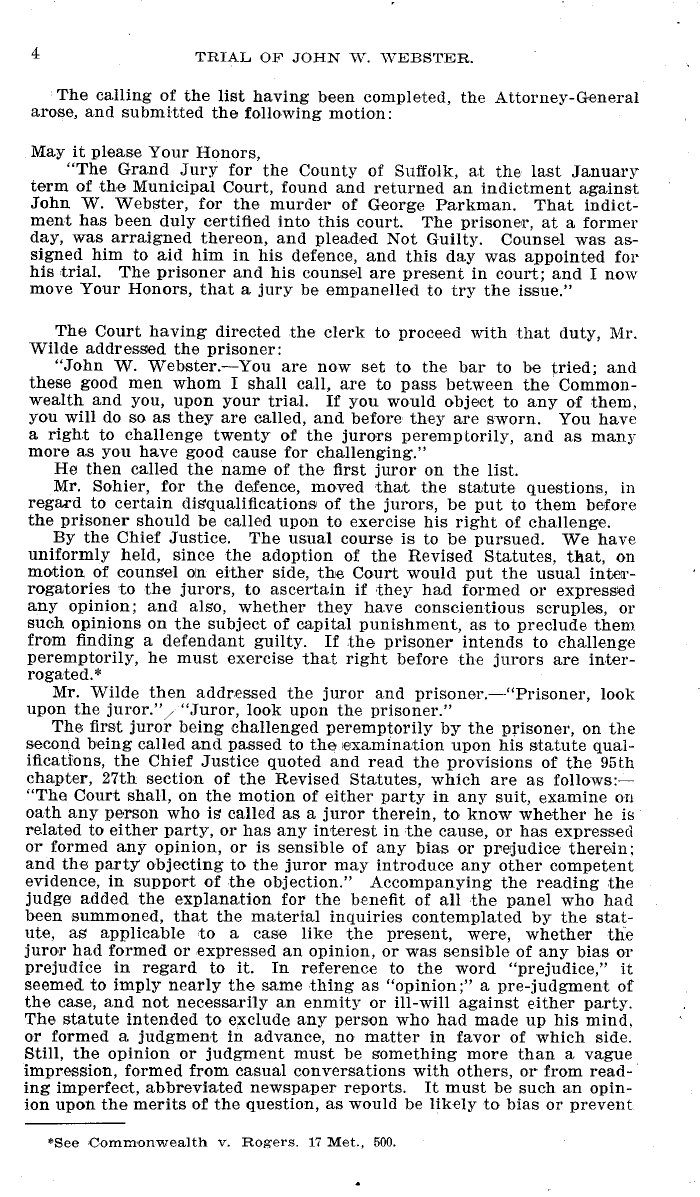|
TRIAL OF JOHN 1S'. WEBSTER.
The calling of the list having been completed, the Attorney-General
arose, and submitted the following motion:
May it please Your Honors,
"The Grand Jury for the County of Suffolk, at the last January
term of the Municipal Court, found and returned an indictment against
John W. Webster, for the murder of George Parkman. That indict-
ment has been duly certified into this court. The prisoner, at a former
day, was arraigned thereon, and pleaded Not Guilty. Counsel was as-
signed him to aid him in his defence, and this day was appointed for
his trial. The prisoner and his counsel are present in court; and I no«•
move Your Honors, that a jury be empanelled to try the issue."
The Court having directed the clerk to proceed with that duty, Mr.
Wilde addressed the prisoner:
"John W. Webster.-You are now set to the bar to be tried; and
these good men whom I shall call, are to pass between the Common-
wealth and you, upon your trial. If you would object to any of them,
you will do so as they are called, and before they are sworn. You have
a right to challenge twenty of the jurors peremptorily, and as many
more as you have good cause for challenging."
He then called the name of the first juror on the list.
Mr. Sohier, for the defence, moved -that the statute questions, in
regaxd to certain disqualifications of the jurors, be put to them before
the prisoner should be called upon to exercise his right of challenge.
By the Chief Justice. The usual course is to be pursued. We have
uniformly held, since the adoption of the Revised Statutes, that, on
motion of counsel on either side, the Court would put the usual inter-
rogatories to the jurors, to ascertain if ,they had formed or expressed
any opinion; and also, whether they have conscientious scruples, or
such opinions on the subject of capital punishment, as to preclude them.
from finding a defendant guilty. If .the prisoner intends to challenge
peremptorily, he must exercise that right before the jurors are inter-
rogated.*
Mr. Wilde then addressed the juror and prisoner.--"Prisoner, look
upon the juror.",, "Juror, look upon the prisoner."
The first juror being challenged peremptorily by the prisoner, on the
second being called and passed to the ,examination upon his statute qual-
ifications, the Chief Justice quoted and read the provisions of the 95th
chapter, 27th section of the Revised Statutes, which are as follows:-
"The Court shall, on the motion of either party in any suit, examine on
oath any person who is called as a juror therein, to know whether he is
related to either party, or has any interest in the cause, or has expressed
or formed any opinion, or is sensible of any bias or prejudice therein:
and the party objecting to the juror may introduce any other competent
evidence, in support of the objection." Accompanying the reading .the
judge added the explanation for the benefit of all the panel who had
been summoned, that the material inquiries contemplated by the stat-
ute, as applicable to a case like the present, were, whether the
juror had formed or expressed an opinion, or was sensible of any bias or
prejudice in regard to it. In reference to the word "prejudice," it
seemed to imply nearly the same thing as "opinion;" a pre-judgment of
the case, and not necessarily an enmity or ill-will against either party.
The statute intended to exclude any person who had made up his mind,
or formed a judgment in advance, no matter in favor of which side.
Still, the opinion or judgment must be something more than a vague
impression, formed from casual conversations with others, or from read-
ing imperfect, abbreviated newspaper reports. It must be such an opin-
ion upon the merits of the question, as would be likely to bias or prevent
*See Commonwealth v. Ropers. 17 Met., 500.
|

